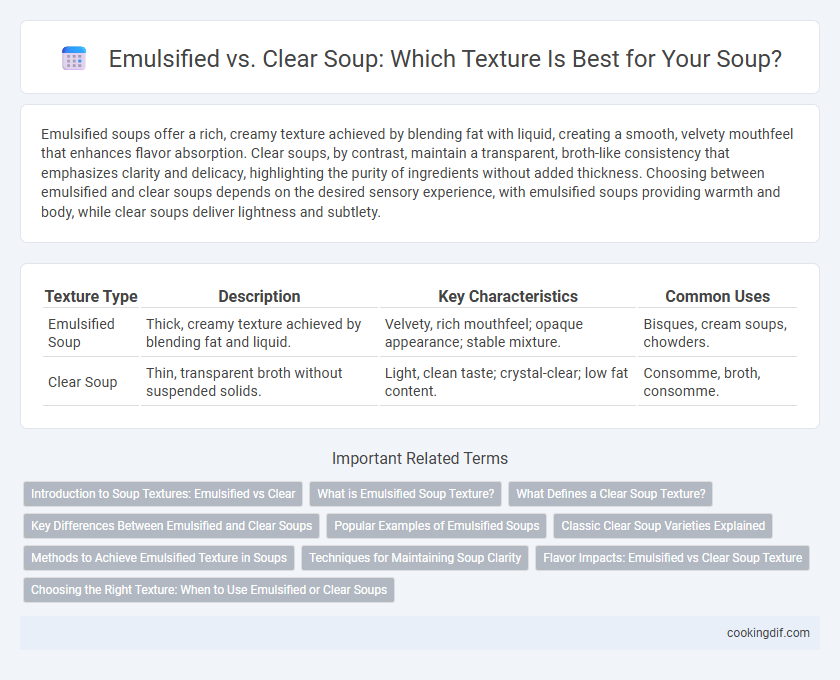Emulsified soups offer a rich, creamy texture achieved by blending fat with liquid, creating a smooth, velvety mouthfeel that enhances flavor absorption. Clear soups, by contrast, maintain a transparent, broth-like consistency that emphasizes clarity and delicacy, highlighting the purity of ingredients without added thickness. Choosing between emulsified and clear soups depends on the desired sensory experience, with emulsified soups providing warmth and body, while clear soups deliver lightness and subtlety.
Table of Comparison
| Texture Type | Description | Key Characteristics | Common Uses |
|---|---|---|---|
| Emulsified Soup | Thick, creamy texture achieved by blending fat and liquid. | Velvety, rich mouthfeel; opaque appearance; stable mixture. | Bisques, cream soups, chowders. |
| Clear Soup | Thin, transparent broth without suspended solids. | Light, clean taste; crystal-clear; low fat content. | Consomme, broth, consomme. |
Introduction to Soup Textures: Emulsified vs Clear
Emulsified soups, such as bisques and creamy chowders, showcase a smooth, velvety texture achieved by blending fats and liquids into a stable mixture that enhances mouthfeel and richness. Clear soups, including consommes and broths, emphasize clarity and purity of flavor with a thin, transparent consistency free from suspended fats or solids. Understanding these two foundational textures helps in selecting appropriate preparation techniques to achieve desired sensory experiences in soup-making.
What is Emulsified Soup Texture?
Emulsified soup texture is characterized by a smooth, creamy consistency achieved by thoroughly blending fat and liquid ingredients into a stable mixture that does not separate. This texture often results from emulsifying agents such as egg yolks, cream, or butter, which create a velvety mouthfeel and enhance flavor integration. Unlike clear soups, emulsified soups maintain an opaque appearance and richer, fuller body, making them ideal for bisques, chowders, and creamy purees.
What Defines a Clear Soup Texture?
A clear soup texture is defined by its transparent and broth-like consistency, free from emulsified fats or particles that cloud the liquid. The clarity is achieved by careful straining and simmering, allowing flavors to infuse without thickening agents or emulsification. Clear soups emphasize a clean, light mouthfeel that highlights the purity of the ingredients.
Key Differences Between Emulsified and Clear Soups
Emulsified soups feature a creamy, opaque texture achieved by blending fat and liquid into a stable mixture, enriching mouthfeel and flavor complexity. Clear soups maintain a translucent appearance with a light, broth-based consistency, emphasizing purity and clarity of taste. The key difference lies in texture and appearance, where emulsified soups provide richness through emulsified fats, while clear soups highlight a clean, unclouded broth.
Popular Examples of Emulsified Soups
Emulsified soups, such as classic French bisques and creamy chowders, achieve a rich, velvety texture by blending fat and liquid into a smooth mixture, contrasting with the transparent clarity of consommes or broths. Popular examples include lobster bisque, which combines shellfish stock with cream and butter for a luxurious mouthfeel, and vichyssoise, a chilled leek and potato soup emulsified to create a silky consistency. These emulsified soups enhance flavor integration and provide a satisfying, indulgent dining experience distinct from the lightness of clear soups.
Classic Clear Soup Varieties Explained
Classic clear soups such as consomme, bouillon, and broth feature a transparent, refined texture achieved through careful straining and clarification processes that remove impurities and fat. These soups emphasize pure, concentrated flavors without the richness or thickness found in emulsified varieties like bisques or cream soups. Clear soups excel as light, palate-cleansing starters that showcase the quality of the stock and fresh ingredients in a visually appealing, translucent form.
Methods to Achieve Emulsified Texture in Soups
Achieving an emulsified texture in soups involves vigorously blending or whisking ingredients to combine fat and liquid into a smooth, homogenized mixture that enhances mouthfeel and richness. Methods like using an immersion blender, incorporating egg yolks as natural emulsifiers, or slowly adding oil or cream while continuously whisking help stabilize the emulsion and prevent separation. Proper temperature control and gradual ingredient integration are critical to maintaining a consistent, velvety texture characteristic of emulsified soups.
Techniques for Maintaining Soup Clarity
Maintaining soup clarity involves precise techniques such as gentle simmering and skimming to remove impurities, preventing cloudiness in clear broths. Using straining methods like cheesecloth or fine mesh ensures the removal of solids while preserving a transparent texture. Emulsified soups rely on controlled blending and gradual incorporation of fats to achieve a smooth, opaque consistency without breaking the emulsion.
Flavor Impacts: Emulsified vs Clear Soup Texture
Emulsified soups create a rich, creamy texture that intensifies flavor by evenly distributing fat and seasonings, enhancing mouthfeel and depth. Clear soups maintain a lighter, more delicate profile, allowing individual ingredients and subtle broth flavors to shine through without heaviness. The choice between emulsified and clear textures directly influences flavor perception, balancing richness against clarity.
Choosing the Right Texture: When to Use Emulsified or Clear Soups
Emulsified soups offer a rich, creamy texture achieved by blending ingredients like cream or butter, ideal for hearty, comforting dishes such as bisques or chowders. Clear soups, including consommes and broths, provide a light, transparent base perfect for delicate flavors and showcasing high-quality ingredients. Selecting between emulsified or clear soup textures depends on the desired mouthfeel, intensity of flavor, and presentation style in culinary preparations.
Emulsified vs Clear for soup texture Infographic

 cookingdif.com
cookingdif.com